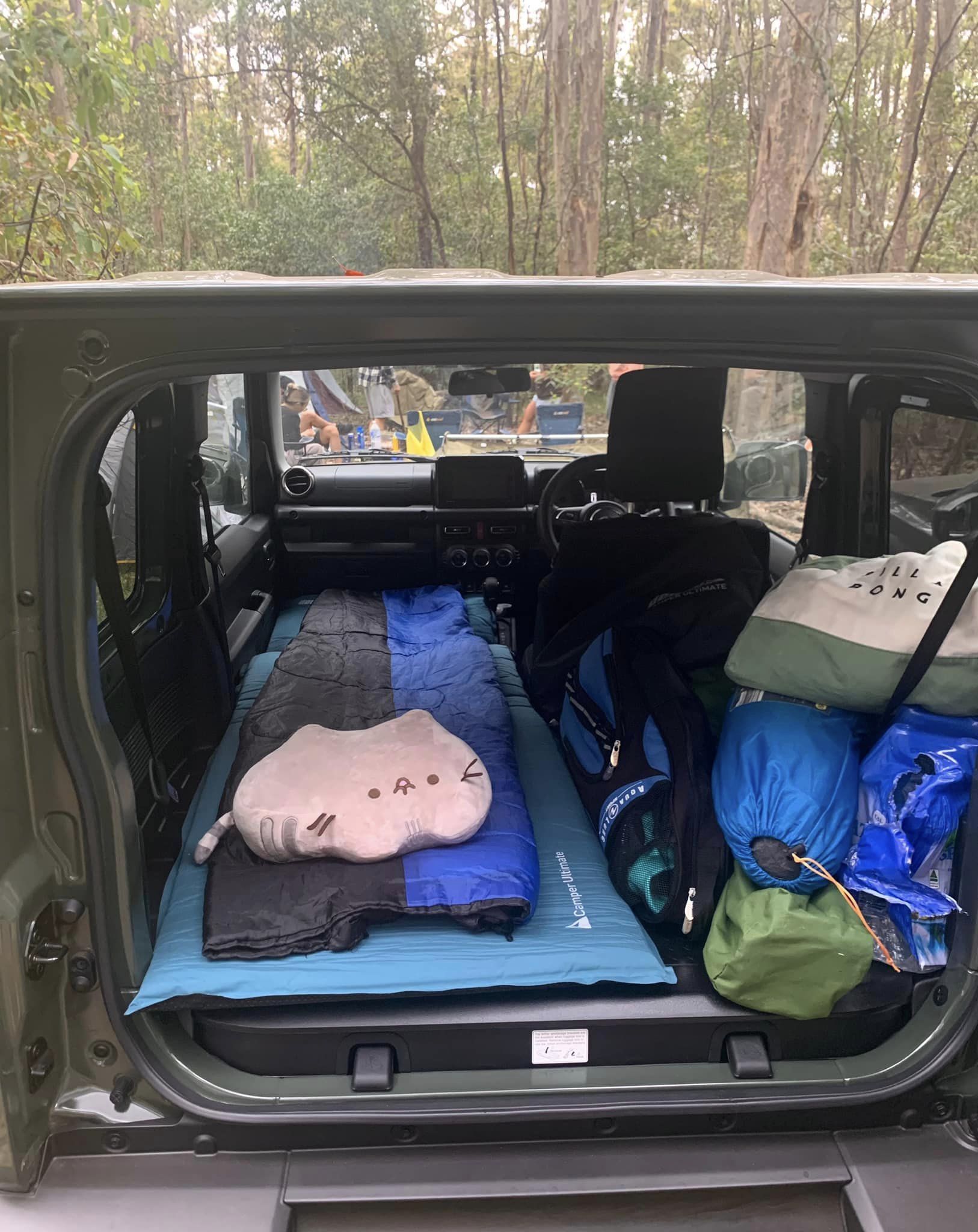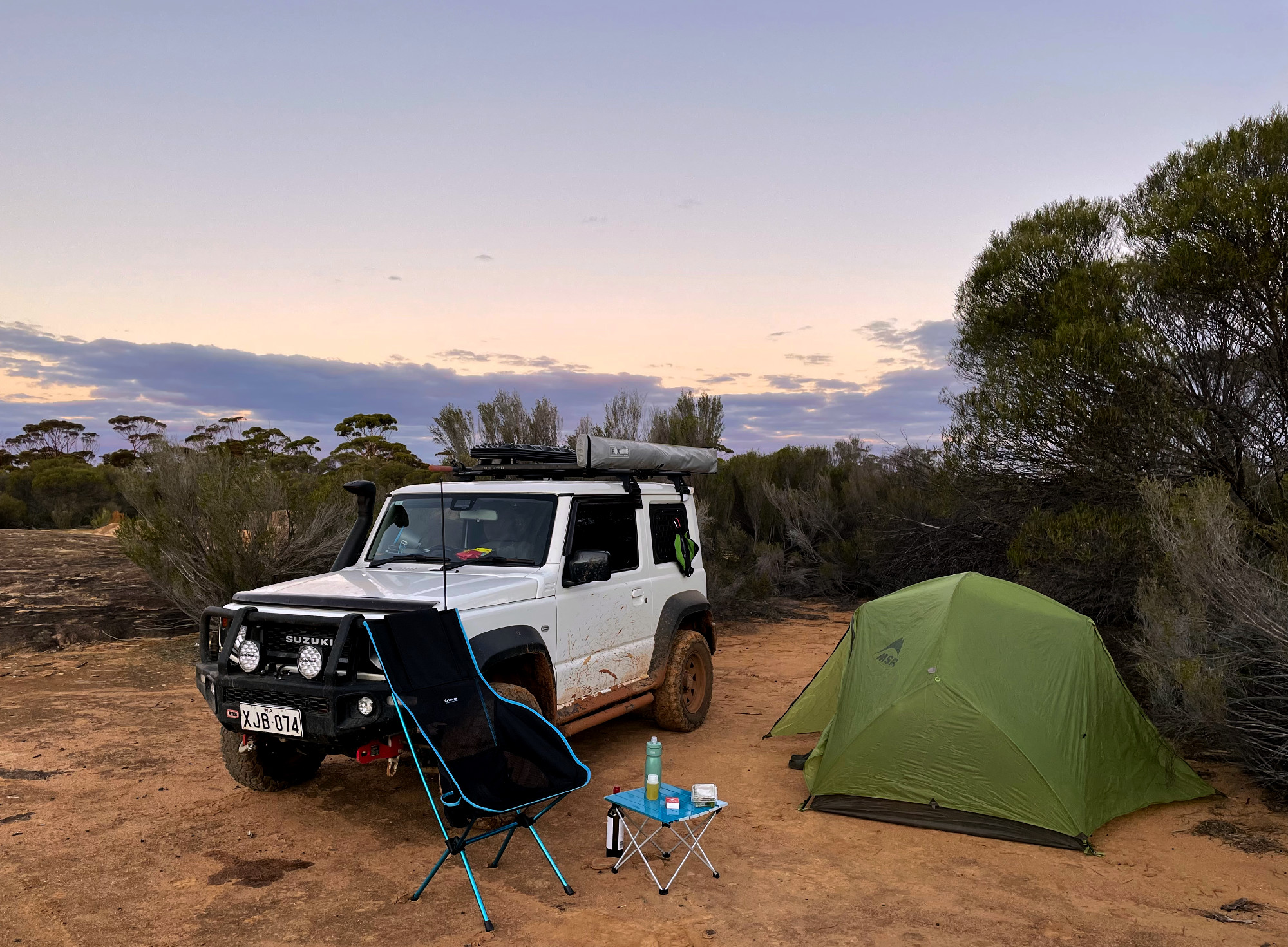Sleeping options
I thought I’d list out some of the sleeping options available to people. Quite often people have their heart or head set on one particular option as it’s their experience or what they’ve seen others use, but there’s a whole heap of options out there. What works for you might not work for others, just like what works for me might not work for you, and that’s ok.
In car sleeping
Tent
In car sleeping
- Comfort: 3-4/5
- Cost: cheap
- Jimnyability: 6/5
The gen4 Jimny 3 doors came with excellent totally lay flat rear seats.

The front seats also move forwards and with the headrests off this lets you fashion the car into a bed on each side of the gear lever/centre console. If you build a false floor for the back, so long as the top of it isn’t really any higher than the wheel arches, and it doesn’t go forwards of where the rear seats end normally then you should be good to go.
There are some tricks to this setup. Usually people sleep on the passengers side for the extra room, but this does mean unless you repack the car all your gear has to sit on the drivers side, making the car maybe more unbalanced if there’s only one passenger. It doesn’t take long to pack your gear and move it but it is a consideration.
The other consideration is around balancing security and ventilation, but also avoiding insects coming in. You can buy insect nets to go over the front doors and have the windows open a little, but if they’re open too far then that always raises the risk of someone poking something in from the outside to unlock your doors. I think if I was going to do this routinely then I would get sliding windows (like I have fitted to my car) and make up little magnetic flyscreens for the back to stop insects coming in. It would be much harder for someone to poke a long stick in and unlock the doors from the back. Also note that this is a good reason to get the Explore Glazing sliding windows: they latch in multiple open positions, so you can have them just barely open but still let in airflow, and make it that little bit more secure. Other windows once they’re open they’re open.
Pros
- Works fantastically for one person, but could be tolerable with 2 if you store the gear outside of the car (or don’t have much!)
- Potentially very secure
- Great for wet weather
- Potentially needs the least gear
Cons
- Harder to achieve in the 5 door Jimny due to the different rear seats
- Not always comfortable depending on your height
- Ventiliation and insect avoidance can be tricky and needs some thought
- Requires you to either set up the car to suit it, or repack your gear for bed
Tent
- Comfort: 2-3/5
- Cost: Cheap to reasonably expensive
- Jimnyability: 5/5
This one is my preference 110% and always has been.

I generally stick to relatively lightweight and quick to erect hiking tents, at the moment I use an MSR Hubba Hubba 2 person tent which I bought (lightly) used for super cheap. This tent is light (< 2 kg with everything including a hammer for the pegs!) and packs down relatively small. It’s also fast to erect. It’s possible to erect the outer rainproof layer (the fly) before the inner part of the tent and this is great for putting it up in rainy conditions.
That’s just part of the kit though. You also need something to sleep on (I use a Sea to Summit hiking mat, but a lot of people might go for a thermarest mat, and there’s also plenty of other brands out there on the various ends of the pricing spectrum). You also need bedding: the classic here is a sleeping bag, but sleeping quilts are also possible and more common in the ultralight world (as it saves the weight and bulk of the material that would be underneath you, and you use the sleeping mat to keep underneath you warm). There’s nothing wrong with just dragging out your own bedding: a single quilt works exceptionally well, and you can get away with relatively inexpensive inflating mattresses for what you sleep on.
Pros
- Can be really cheap to get into, though tent quality improves with spending more
- Potentially one of the lightest weight and smallest options: very Jimnyable
- More internal room for activities than a swag
Cons
- Setup time (though not much worse than most modern swags with their poles)
- Need to remember all the components as nothing’s built in
- It might take a bit of experimentation to find what you like.
(Buying 2nd hand is good for this – if you don’t like it, sell it on and get something else!)
Swag
- Comfort: 4/5
- Cost: medium
- Jimnyability: 3/5
Swags are the absolutely iconic piece of Australian camping equipment, and I think that’s part of what drives their continued popularity. It really looks like you’re properly going bush with a swag loaded up.
Swags provide you a way of having all your bedding contained: sure, you could leave your hiking mat inside your tent to make it slightly quicker to set up, but you’re still inflating it or waiting for it to inflate. Swags also are made of durable and thick fabric.
With that fabric and all in one component, though, you have two drawbacks: size, and weight. The size is a big thing in something like the Jimny: unless you go a motorbike swag you will find they can take up a fair amount of the back of the car. You can strap them to the roof but then they become a big aerodynamic drag and might buffet the car around more on the highway. While you don’t need a roof platform, something as unstructured and bulky as a swag is easier to secure with a platform. (It’s possible to just use roof crossbars and a couple of pieces of timber or metal poles between the crossbars to support the swag, though).
Pros
- All in one: throw it out, erect the poles, and you’re good to go
- Sleep comfort can be high (but depends on the included mattress)
- Excellent for sleeping in with canvas transmitting limited light through it
Cons
- With a few exceptions they are heavy and bulky, so some consideration is needed
- Great in colder camping situations, less great in hot situations
- Luxo models can get up there in price
Stretcher bed options
- Comfort: 4/5 (6/5 for bug avoidance)
- Cost: medium
- Jimnyability: 2/5
These can take the form of a stretcher swag and/or a stretcher as part of your bedding setup with a tent. You could even class camping hammocks in this category, too. They can be relatively bulky and hard to fit in the Jimny though not impossible, especially as some can fold up quite small.
Some people absolutely love the sleeping comfort of a hammock and they can be super supportive. You’re also up off the ground so no awkward rocks or sticks digging into your back during the night. One downside is insulation and coldness underneath you: you are insulated from the cold ground, but if cold air can actually move around underneath you then it can end up colder through advection. Just worth understanding that the insulation beneath you in however you sleep will matter more.
I have a stretcher and I quite like it, though I rarely use it in the Jimny.
Pros
- The ultimate in avoiding bugs on the ground and creepy-crawlies
- Some people feel they give wonderful sleep
- Can be a really luxurious feel: you feel far less poor sleeping in an elevated position than having to sleep on the ground.
Cons
- Can be cold depending on insulation and air temperatures/wind
- Relatively bulky, especially if combined with a swag
Rooftop tent
Comfort: 5/5
Cost: high
Jimnyability: 0-0.5/5
A lot of people look at rooftop tents and get super excited by them. I get the attraction, but it is worth understanding the full implications of the Jimnys 30 kg roof load limit. Basically no roof top tent comes in under that weight especially once mounting considerations are given.
Roof top tents can give a very luxurious experience. The view from up high can be amazing, and it can be a good feeling for security. They generally have a better bedding arrangement than a swag and definitely than a tent, and everything’s there so just set up and you’re there.
Other than the roof load limit, a RTT isn’t without its drawbacks. If you want to go exploring away from camp then packing up everything is required, whereas a swag or tent you might leave setup. Nighttime toilet missions are a lot more precarious when you have to navigate down a small ladder in the middle of the night, potentially not being able to see where you’re going. They also can be quite expensive, even for the cheapest and lightest ones out there. You are also limited about putting other things on the roof: sometimes you’re going to struggle with an awning on at the same time, notwithstanding the issues that would add to with the roof load limit. You also aren’t going to be throwing your recovery boards up there, either.
These can be great combined with offroad trailers, though, which we’ll touch on; if you really like the idea of an RTT then one attached to an offroad trailer might be a very Jimny capable setup!
Pros
- All in one setup: just erect it and your bedding is there
- Almost no worries about putting away a wet tent or swag
- Really good privacy, security and (assuming the insect netting is good) great against insects and creepy crawlies.
Cons
- Doesn’t fit in under the Jimny’s roof load limit
- Weight up high is terrible for highway handling not to mention increasing your risk of tipping the car over offroad
- Quite expensive especially once roof racks and things are considered, and can reduce what else you can have on the roof (like recovery boards, even potentially awnings)
- Requires packing away if you’re going exploring away from camp during the day
Road biased caravan/camper trailer
Comfort: 5/5
Cost: high
Jimnyability: 2/5
Offroad biased caravan/camper trailer
Comfort: 4/5
Cost: high
Jimnyability: 4/5
